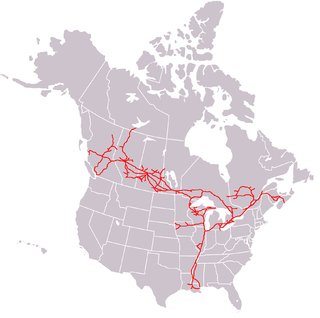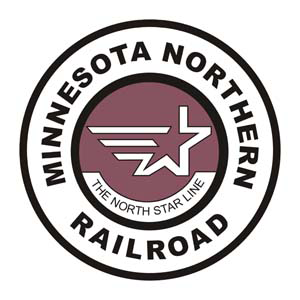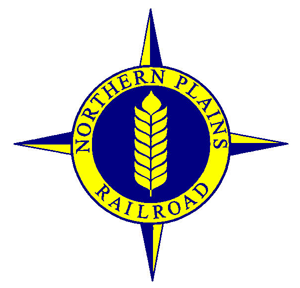
The Canadian Pacific Railway, also known simply as CPR or Canadian Pacific and formerly as CP Rail (1968–1996), was a Canadian Class I railway incorporated in 1881. The railway was owned by Canadian Pacific Railway Limited, which began operations as legal owner in a corporate restructuring in 2001.

The Canadian National Railway Company is a Canadian Class I freight railway headquartered in Montreal, Quebec, which serves Canada and the Midwestern and Southern United States.

BNSF Railway is the largest freight railroad in the United States. One of six North American Class I railroads, BNSF has 35,000 employees, 32,500 miles (52,300 km) of track in 28 states, and nearly 8,000 locomotives. It has three transcontinental routes that provide rail connections between the western and eastern United States. BNSF trains traveled over 169 million miles in 2010, more than any other North American railroad.

The Soo Line Railroad is one of the primary United States railroad subsidiaries for the CPKC Railway, one of six U.S. Class I railroads, controlled through the Soo Line Corporation. Although it is named for the Minneapolis, St. Paul and Sault Ste. Marie Railroad (MStP&SSM), which was commonly known as the Soo Line after the phonetic spelling of Sault, it was formed in 1961 by the consolidation of that company with two other CPKC subsidiaries: The Duluth, South Shore and Atlantic Railway, and the Wisconsin Central Railway. It is also the successor to other Class I railroads, including the Minneapolis, Northfield and Southern Railway and the Chicago, Milwaukee, St. Paul and Pacific Railroad. On the other hand, a large amount of mileage was spun off in 1987 to Wisconsin Central Ltd., now part of the Canadian National Railway. The Soo Line Railroad and the Delaware and Hudson Railway, CPKC's other major subsidiary, presently do business as the Canadian Pacific Railway (CP). Most equipment has been repainted into the CP scheme, but the U.S. Surface Transportation Board groups all of the company's U.S. subsidiaries under the Soo Line name for reporting purposes. The Minneapolis headquarters are located in the Canadian Pacific Plaza building, having moved from the nearby Soo Line Building.

The Wisconsin and Southern Railroad is a Class II regional railroad in Southern Wisconsin and Northeastern Illinois currently operated by Watco. It operates former Chicago, Milwaukee, St. Paul and Pacific Railroad and Chicago and North Western Railway (C&NW) trackage, mostly acquired by the state of Wisconsin in the 1980s.

The Chicago and North Western was a Class I railroad in the Midwestern United States. It was also known as the "North Western". The railroad operated more than 5,000 miles (8,000 km) of track at the turn of the 20th century, and over 12,000 miles (19,000 km) of track in seven states before retrenchment in the late 1970s. Until 1972, when the employees purchased the company, it was named the Chicago and North Western Railway.

The Iowa, Chicago and Eastern Railroad (IC&E) was a Class II railroad operating in the north central United States. It has been controlled by the Canadian Pacific Railway and operated as a part of its system since October 30, 2008. Formerly, the IC&E was jointly owned with the Dakota, Minnesota and Eastern Railroad by Cedar American Rail Holdings (CARH), making the combined system the largest class II railroad in the United States. Created by the purchase of I&M Rail Link, IC&E commenced operations on July 30, 2002. The 1,400-mile (2,300 km) line, based in Davenport, Iowa, serves the states of Illinois, Iowa, Missouri, Minnesota and Wisconsin. Principal commodities include chemicals, coal, steel, automobiles, and agricultural products. Train dispatching is performed at a joint DM&E/IC&E facility in Sioux Falls, South Dakota. On December 26, 2008, the IC&E was merged into parent CARH, which immediately merged into the DM&E.
The I&M Rail Link was a railroad operating in the north central portion of the United States. The company commenced operations on April 5, 1997, acquiring lines from the Canadian Pacific Railway and Soo Line Railroad.

The Minnesota Northern Railroad is a Class III shortline railroad that operates over 224 miles (360 km) of track in northwestern Minnesota. The railroad is co-owned by KBN Incorporated and Independent Locomotive Service and is headquartered in Crookston, Minnesota.

The Northern Plains Railroad is a short line railroad that operates over 344 miles (554 km) of track in the northern U.S. state of Minnesota and the northern U.S. state of North Dakota.

The Iowa Northern Railway is a Class III shortline railroad operating in the U.S. state of Iowa.

Pan Am Southern, LLC is a freight railroad jointly owned by Norfolk Southern Railway (NS) and CSX Corporation subsidiary Pan Am Railways (PAR). After the June 2022 acquisition of PAR by CSX, PAS will be independently operated by the Berkshire and Eastern Railroad, a subsidiary of Genesee & Wyoming. PAS owns trackage known as the Patriot Corridor between Albany, New York, and the Boston, Massachusetts, area, utilizing rail lines formerly owned by the Fitchburg Railroad and later on the Boston and Maine Railroad. It was previously operated by PAR subsidiary Springfield Terminal Railway.
The Waseca Subdivision or Waseca Sub is a railway line in southern Minnesota owned and operated by the Dakota, Minnesota and Eastern Railroad (DM&E) subsidiary of Canadian Pacific. It stretches roughly 103 miles (166 km) from Winona, Minnesota in the east to Waseca in the west where the rails continue as the Tracy Subdivision. There's also a connection south to the Hartland Subdivision. U.S. Highway 14 closely follows the railroad line.
The Tracy Subdivision or Tracy Sub is a railway line in southern Minnesota owned and operated by the Dakota, Minnesota and Eastern Railroad (DM&E) subsidiary of Canadian Pacific. It begins at the end of the Waseca Subdivision in Waseca, Minnesota in the east and runs approximately 124 miles (200 km) west to Tracy, Minnesota. At Tracy, the rails continue as the Huron Subdivision of the Rapid City, Pierre and Eastern Railroad (RCPE). U.S. Highway 14 closely follows the train route.
The Owatonna Subdivision or Owatonna Sub is a railway line in northern Iowa and southern Minnesota owned and operated by the Iowa, Chicago and Eastern Railroad (IC&E) subsidiary of Canadian Pacific. It extends about 124 miles (200 km) from Mason City, Iowa in the south to a junction at Comus north of Faribault, Minnesota. U.S. Highway 218 closely follows the rail line between Lyle, Minnesota and Owatonna.
The Winona and St. Peter Railroad was a railroad in the Midwestern United States. It was founded in 1861 in Winona, Minnesota. The first 11 miles (18 km) from Winona to Stockton, Minnesota, were completed by the end of 1862, making the it the second operational railroad in Minnesota, after the St. Paul and Pacific Line from Saint Paul to St. Anthony Falls.

The Central Maine & Québec Railway was a Class II freight railroad operating in the U.S. states of Maine and Vermont and the Canadian province of Quebec with headquarters in Bangor, Maine. It was owned by Railroad Acquisition Holdings, LLC, a subsidiary of Fortress Investment Group, LLC. It is now a subsidiary of Canadian Pacific Railway since June 2020.

Rapid City, Pierre & Eastern Railroad is a Class II freight railroad operating across South Dakota and southern Minnesota in the northern plains of the United States. Portions of the railroad also extend into Wyoming and Nebraska. It is owned and operated by Genesee & Wyoming. The primary commodities shipped are grain, clay, and cement. Operations began on June 1, 2014.

The Winona Subdivision or Winona Sub is a railway line operated by Union Pacific Railroad. The Union Pacific owns 1.8 miles (2.9 km) of rail in downtown Winona, Minnesota. The UP reaches Winona using the River Subdivision and Tomah Subdivision of the Canadian Pacific Railway. The railroad services the Winona Terminal area on the Mississippi River.



















